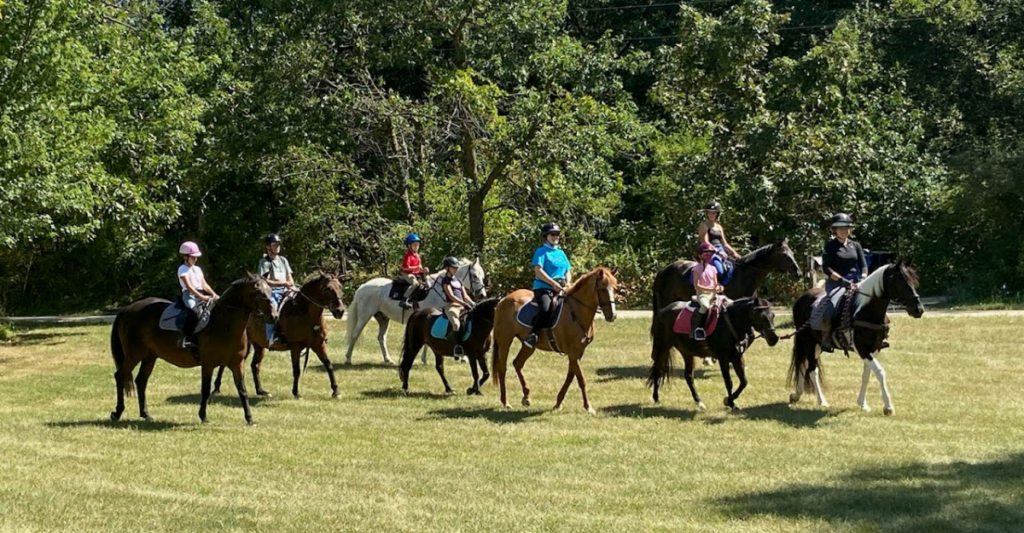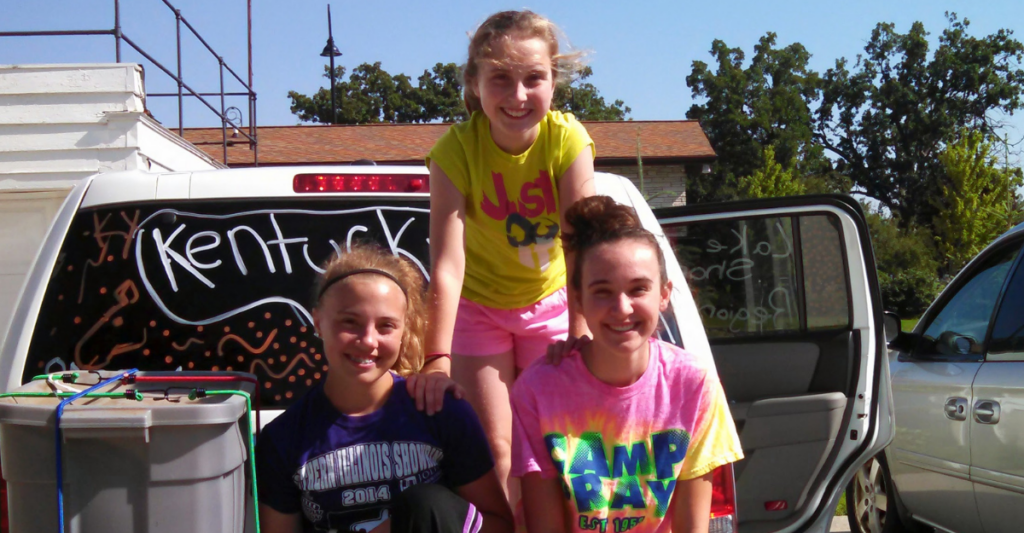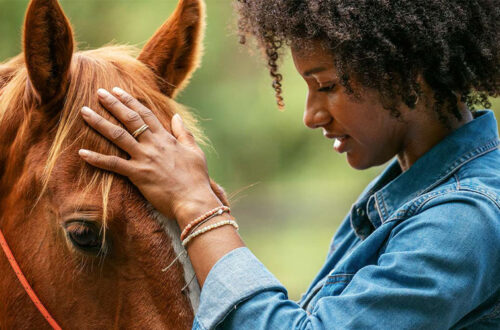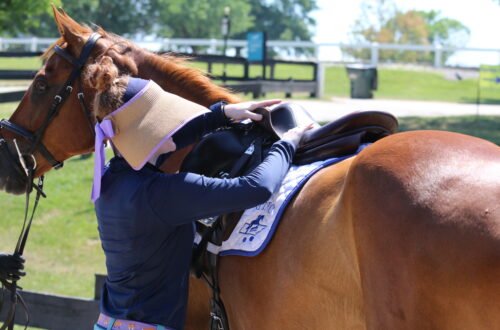
Summer Travel and Conditioning Tips
By Rae A. Birr, DVM
So you have decided to bring your horse to the Kentucky Horse Park for USPC Festival 2021 presented by SSG Riding Gloves and sponsored by State Line Tack. Great news, and congratulations on embarking on a fun and busy plan!
It’s important to be well prepared for your trip to Kentucky. This includes horse athlete conditioning, human athlete conditioning, and equipment preparation such as tack, rally equipment, truck and trailer, feed and a travel itinerary.
This article will cover some of the considerations for arriving safely and getting your horse fit for the hot and humid weather at the Kentucky Horse Park in July. Even if you live where the summer temperatures are routinely hot and humid, there are still some conditioning pointers to consider.
Prepare a Conditioning Plan
Write a conditioning plan—just like you would need for your H-B certification. If you are not yet an H-B, you can ask for help from a National Level Pony Club member or a trainer. Plan weeks ahead to prepare your mount for the heat, humidity and exertion we will expect in July. If you are dealing with winter weather that limits riding, be sure to start slowly and increase exercise in a routine manner when regular riding can occur. Horses have amazing muscle memory so if they have ever been fit before it is easier to regain the last level of fitness than it is to start with a horse that has never been fit. The trick with a horse that gains fitness fast is to not over-condition and not push them too fast. It is better to gain condition and plateau for a little while and then add to your base.
No matter how well-trained your mount is, the travel and weather conditions in Kentucky will be a drain on the horses, so they need to be properly acclimated. Conditioning muscles, tendons, ligaments, bones and cardiovascular system is a balancing act of adding enough stress and strain to get the body to add more strength without overdoing the stress and causing breakdown of tissue and systems. This statement is not meant to be alarming, but to show that there is some art, not just science, to a good conditioning program!

Monitor your mount regularly. Know your horse’s resting pulse, respiration and body temperature parameters. Check them before you ride. Follow pulse especially as you add more riding time and stress. How long does it take your horse to return to a resting pulse after you gallop around the pasture or jump a Show Jumping course? Look for the time it takes to return to resting levels to be reduced even as you add more strenuous activities to your rides. When you cannot get a rapid recovery (10 minutes or less), then you are pushing too hard and need to back off your program a little, perhaps even give an extra day off. Monitor tendons and ligaments for heat, pain or swelling (the definition of inflammation) before and after your rides and be prepared to reduce the stress if there is inflammation. Know your horse and learn more about his responses to exercise stress.
Practice riding in the heat of the day, and ride more than once a day. These steps will help you and your horse be ready for the heat in Kentucky. Do your horse a kindness by going to the barn to ride when the air conditioning is where you want to stay. This will help acclimate both you and your horse so that you’ll be ready to do your best.
Help your horse learn to enjoy cool baths. Sometimes this takes the use of bucket after bucket of water rather than a hose but be sure you and your horse have developed a method that is low stress for cooling out. And remember that water acts to transfer heat from the horse’s body, so you want to be constantly replacing cool water with a large volume of water (perhaps a hose or mister) or dousing and scraping the hot water off and replacing with new cool water (sponging). A fan can help enhance evaporative cooling in humid air. Keep going with cool water until the skin is cool to the touch and does not heat back up after scraping or drying.

Safe Summer Travel
Riding in our air-conditioned trucks and cars, we do not realize how hot it can get in a horse trailer. A good plan for long travel over heat-baked roads is to add an extra layer of mats to your trailer. This helps insulate the horses’ feet from the heat radiating off the road surface. The extra padding is also good cushion for joints standing for long hours. Be sure you have good air flow through the trailer with adequate screening for protection from dust and debris in the horses’ eyes and ears. Fly scrims or window screens are safest. Never travel with the horses’ heads outside the trailer. As a veterinarian, I have seen horrendous injuries and death when horses can hang their heads out open windows while traveling down the road.
Plan to travel in the cool of the day. Make stops every few hours to offer water and potentially a walk outside the trailer. Find safe locations to stop, off of interstate highways and away from large, noisy truck stops. Even if you do not unload the horses, 30 minutes of standing still gives the travelers a needed break from balancing in the trailer. As a rule of thumb, 200 miles riding in the trailer is the same muscle workout as riding 50 miles. They have to work to stay standing in a moving trailer. Untying their heads so they can drop their head down will help drain the mucus that accumulates in the airways and lets gravity assist the normal mucus clearing mechanisms. It is a good idea to remove manure and soiled shavings as you travel. Manure and urine incubate bacteria and fumes that are noxious to a horse, even when there is good air flow.
Carry water from home with you. Many horses will refuse unfamiliar water and the last thing you want is a dehydrated horse. Sometimes it works to flavor your horse’s water so they are used to a certain taste to water. Try this at home before you head out this summer. A few teaspoons of flavored gelatin granules can sometimes mask new water. Be careful not to use too much flavoring, as they don’t need the sugar. Try to work over to plain water when you are settled. It’s a good idea to carry enough water with you for drinking, truck engine needs, and horse cooling. In extreme heat, having ice in a cooler may help with needed cooling.
Horsemen have different ideas about feeding horses in a trailer and this article will not address all of those ideas, but it is important for the horse’s system to have food moving through and plenty of moisture for normal digestion. Feed a snack of soaked hay cubes or hydration hay or hay tea (soak hay in cold water and offer the resulting “tea” to drink) with or without some stomach support such as aloe vera juice, UlcerGard or Purina Outlast. Practice with your chosen snack before your trip. Introducing a new food while traveling may upset a horse’s stomach.
Electrolytes are salts that circulate in the bloodstream and fluids of the body. Horses lose gallons of liquid and these salts when they sweat. Supplementing electrolytes may be a good idea or even a necessity for good bodily functions in heat and humidity. A simple recipe for electrolyes is one part table salt (NaCl) and two parts Morton Lite Salt (mostly KCl). A heaping tablespoon is a basic dose and can be given in feed, water or by syringe. Supplementing electrolytes is appropriate for trailer travel in heat and before during and after strenuous exercise. Practice giving electrolytes at home and find the best method to get your horse to accept them. Fresh water should always be available even when you offer electrolytes in water. If your horse is not drinking well, do not give electrolytes to stimulate thirst. While a bag of salty potato chips will make a human want to drink more water, salt does not have the same effect on horses and electrolytes without adequate hydration will serve to dehydrate a horse more.
Traveling with horses can be an adventure. Make plans ahead of time so that you can have fun as you travel to Festival this summer. See you there!
Rae A Birr, DVM, is a graduate of Michigan State University College of Veterinary Medicine with a special interest in equine medicine and sport horse care. She has been involved with USPC since the 1970s, attaining a B certification, serving in local leadership positions and currently as Lake Shore Region Regional Supervisor, as a Governor on the Board and as Marketing and Communications Committee chair.
A version of this article originally appeared in the Spring 2021 issue of Discover USPC magazine. Click here to read it in the digital edition.





